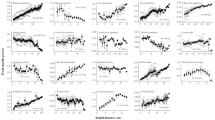Abstract
Key message
Ray and axial parenchyma frequency, observed in cross-sections of mature Abies alba trunks is not related to tree-ring width.
Abstract
We studied the relationship between tree-ring width and frequency of ray and axial parenchyma of mature silver fir (Abies alba Mill.) to assess whether the selected wood-anatomical variables contain complementary or redundant environmental or physiological information. Cross-sections from 400 tree rings were analysed by transmitted light microscopy and image analysis. We found no relevant correlation between the tree-ring width, expressed by the number of cells along three radial files, and the number of rays (i.e. the sum of all rays, where the partial rays are present along half of the tree-ring width) per unit area. Despite statistically significant correlation, more or less constant number of rays (on average between 6 and 7) over the whole range of the tree-ring widths was observed. Similarly, we did not find a significant correlation between the number of axial parenchyma cells and the tree-ring width. A lack of relevant association between the number of rays or axial parenchyma cells per unit area and the tree-ring width indicates that the studied wood-anatomical variables may contain environmental or physiological information different from that stored in tree-ring widths. However, further wood anatomical analyses of long tree-ring series are needed to evaluate the potential of ray parenchyma as a climate proxy.


Similar content being viewed by others
References
Bannan MW (1937) Observations on the distribution of xylem-ray tissue in conifers. Ann Bot 1:717–726
Bannan MW (1954) Ring width, tracheid size, and ray volume in stem wood of Thuja occidentalis L. Can J Bot 32:466–479. doi:10.1139/b54-042
Eckstein D (2013) ‘A new star’—but why just parenchyma for dendroclimatology? New Phytol 198:328–330. doi:10.1111/nph.12229
Fonti P, von Arx G, García-González I, Eilmann B, Sass-Klaassen U, Gärtner H, Eckstein D (2010) Studying global change through investigation of the plastic responses of xylem anatomy in tree rings. New Phytol 185:42–53. doi:10.1111/j.1469-8137.2009.03030.x
Gartner BL, Baker DC, Spicer R (2000) Distribution and vitality of xylem rays in relation to tree leaf area in Douglas-fir. IAWA J 21:389–401
Gregory RA, Romberger JA (1975) Cambial activity and height of uniseriate vascular rays in conifers. Bot Gaz 136:246–253
Grosser D (1977) Die Hölzes Mitteleuropas. Springer, Berlin
Lev-Yadun S (1998) The relationship between growth-ring width and ray density and ray height in cell number in the earlywood of Pinus halepensis and Pinus pinea. IAWA J 19:131–139
Lev-Yadun S, Aloni R (1995) Differentiation of the ray system in woody plants. Bot Rev 61:45–84
Olano JM, Arzac A, García-Cervigón AI, von Arx G, Rozas V (2013) New star on the stage: amount of ray parenchyma in tree rings shows a link to climate. New Phytol 198:486–495. doi:10.1111/nph.12113
Rao RV, Aebischer DP, Denne MP (1997) Latewood density in relation to wood fibre diameter, wall thickness, and fibre and vessel percentages in Quercus robur L. IAWA J 18:127–138
Schultze-Dewitz G (1961) Notes concerning the influence of the position of a tree on its anatomical structure. Holzforschung 15:89–91
van der Werf GW, Sass-Klaassen U, Mohren GMJ (2007) The impact of the 2003 summer drought on the intra-annual growth pattern of beech (Fagus sylvatica L.) and oak (Quercus robur L.) on a dry site in the Netherlands. Dendrochronologia 25:103–112
Acknowledgments
The authors gratefully acknowledge the help of Urška Mihoci, undergraduate student at the Department of Forestry and Renewable Resources at the Biotechnical Faculty, University of Ljubljana, as well as Špela Jagodic at the Slovenian Forestry Institute for their help in the laboratory. We thank Martin Cregeen for language editing. In addition, the authors would like to thank the communicating editor and the reviewers for their valuable comments and suggestions to improve the quality of the paper. The work was supported by the Slovenian Research Agency, programs P4-0107 and P4-0085, projects Z4-9662, V4-0496, L7-2393 and by EUFORINNO (RegPot No. 315982) of the FP7 Infrastructures programme. The authors would like to acknowledge the contribution of the COST Action FP1106, STReESS.
Conflict of interest
The authors declare that they have no conflict of interest.
Author information
Authors and Affiliations
Corresponding author
Additional information
Communicated by S. Leavitt.
Rights and permissions
About this article
Cite this article
Gričar, J., Eler, K. The frequency of ray and axial parenchyma versus tree-ring width in silver fir (Abies alba Mill.). Trees 29, 1023–1027 (2015). https://doi.org/10.1007/s00468-015-1181-8
Received:
Revised:
Accepted:
Published:
Issue Date:
DOI: https://doi.org/10.1007/s00468-015-1181-8




